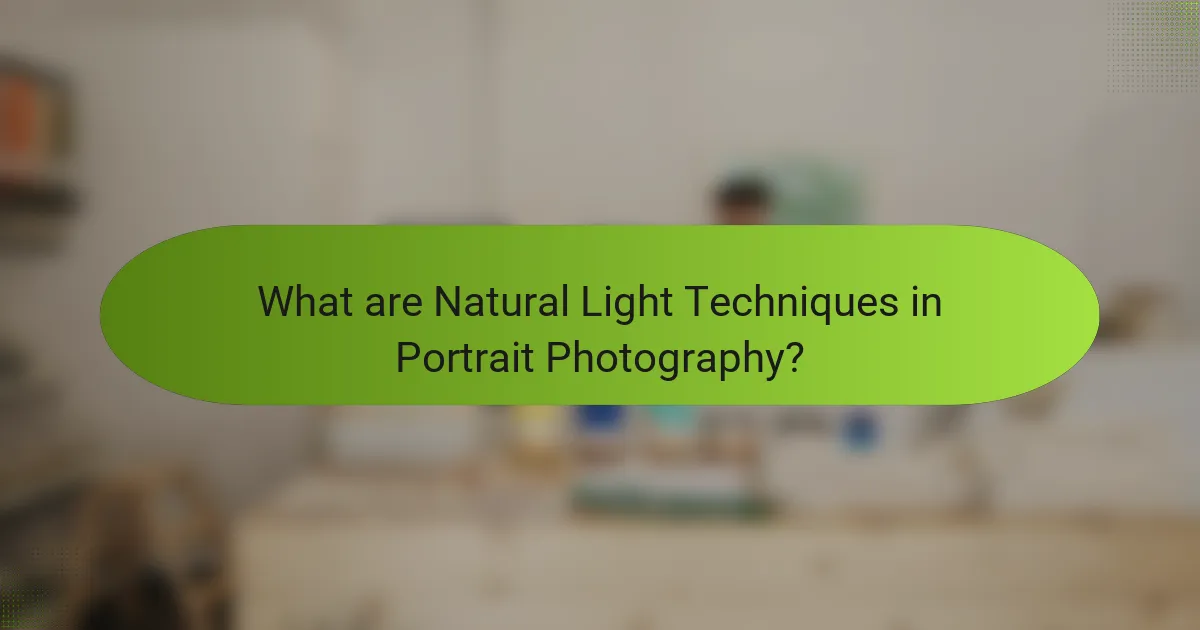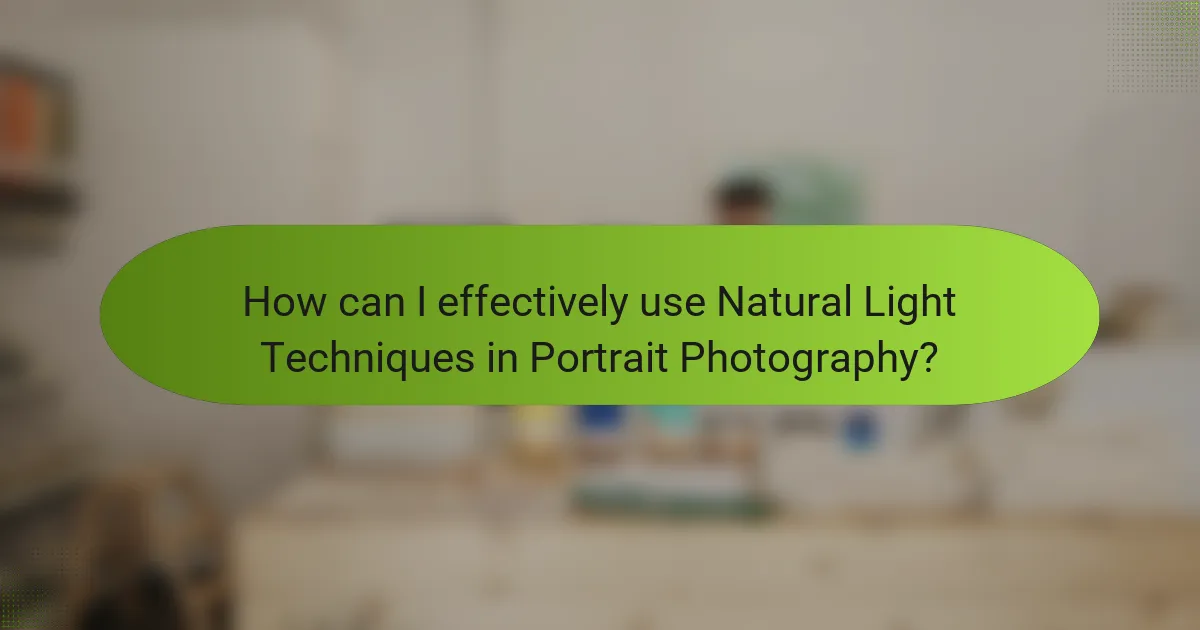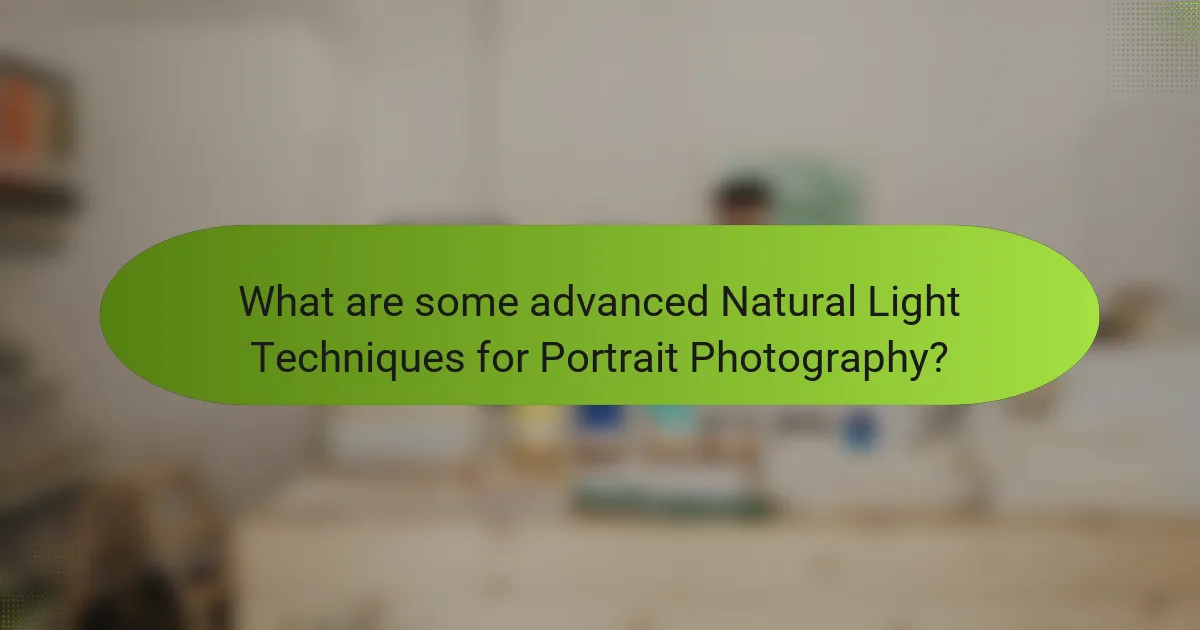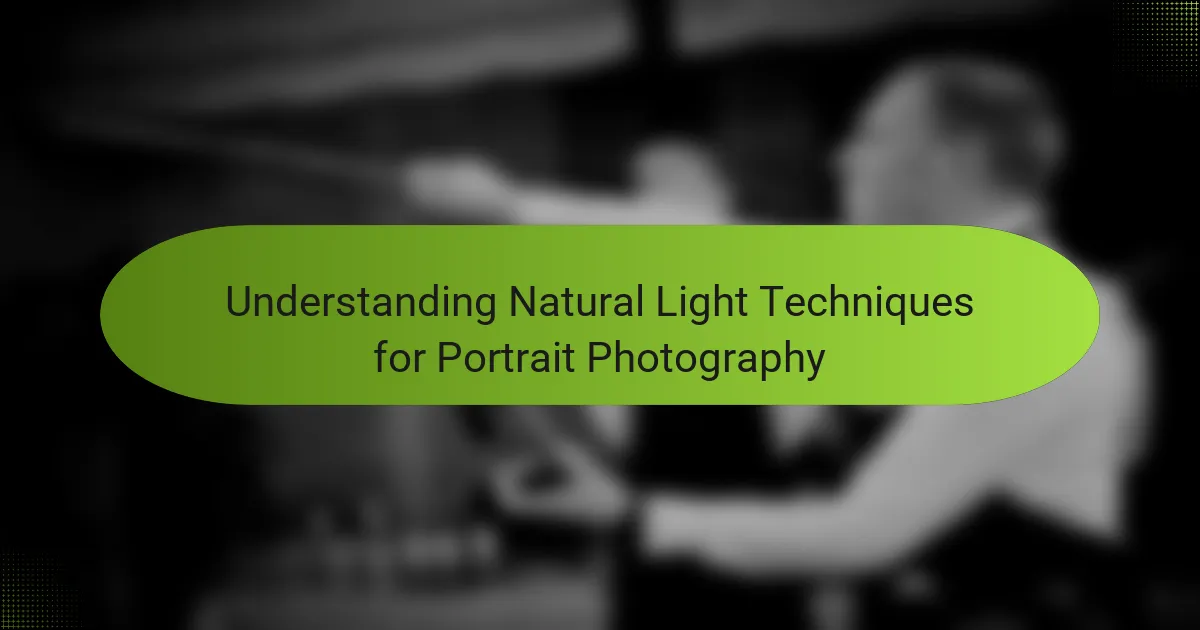
What are Natural Light Techniques in Portrait Photography?
Natural light techniques in portrait photography utilize sunlight as the primary light source. These techniques include using natural light during golden hour for soft, flattering illumination. Photographers often position subjects to face or be angled towards the light source. This enhances [censured] features and reduces harsh shadows. Reflectors may be used to bounce light onto the subject, filling in shadows. Overcast days provide diffused light, resulting in even skin tones. Backlighting creates a halo effect, adding depth and interest to portraits. These methods are widely practiced for their ability to create natural and engaging images.
How do Natural Light Techniques differ from other photography techniques?
Natural light techniques utilize sunlight as the primary light source in photography. This contrasts with other techniques that often rely on artificial lighting, such as flash or studio lights. Natural light techniques emphasize the quality of light available at different times of day. They capture the softness of dawn or the warmth of sunset, which can enhance the subject’s features.
In comparison, artificial lighting can create harsher shadows and a more controlled environment. Natural light is also dynamic, changing rapidly with weather and time, which can lead to unique and spontaneous results. Photographers using natural light must adapt to these changes, unlike those using artificial setups that offer more consistency.
Studies show that portraits taken in natural light often have a more authentic feel, as they reflect real-world conditions. This authenticity can resonate more with viewers, making natural light a preferred choice for many portrait photographers.
What are the fundamental principles of using natural light?
The fundamental principles of using natural light involve understanding its direction, quality, and intensity. Direction refers to where the light source is located relative to the subject. Front lighting can reduce shadows, while side lighting can create depth. Quality describes whether the light is soft or harsh. Soft light, often found on overcast days, reduces shadows. Harsh light, typical during midday, creates strong contrasts. Intensity indicates how strong the light is, which can change based on time of day and weather conditions. The golden hour, shortly after sunrise and before sunset, provides warm, diffused light ideal for portraits. Understanding these principles allows photographers to manipulate natural light effectively for desired effects.
Why is natural light preferred for portrait photography?
Natural light is preferred for portrait photography because it creates soft and flattering illumination. This type of light reduces harsh shadows and highlights on the subject’s face. Natural light is also versatile, varying in quality throughout the day. The golden hour, shortly after sunrise or before sunset, provides warm tones that enhance skin textures. Additionally, natural light is readily available and cost-effective, eliminating the need for expensive lighting equipment. Studies show that portraits taken in natural light often appear more genuine and emotionally resonant. Photographers frequently utilize reflectors to manipulate natural light for optimal results. Overall, natural light contributes to a more organic and appealing aesthetic in portrait photography.
What are the different types of Natural Light Techniques?
The different types of natural light techniques include backlighting, side lighting, and diffused lighting. Backlighting occurs when the light source is behind the subject. This technique creates a silhouette effect and enhances the subject’s outlines. Side lighting involves placing the light source to the side of the subject. It accentuates textures and creates depth through shadows. Diffused lighting happens when the light is softened, often by clouds or reflectors. This technique reduces harsh shadows and creates a more even illumination. Each technique offers unique visual effects that can enhance portrait photography.
How does the time of day affect natural light in photography?
Natural light in photography varies significantly throughout the day. During sunrise and sunset, known as the golden hour, the light is soft and warm. This quality enhances skin tones and creates dramatic shadows. Midday light is harsh and can result in unflattering contrasts. It often creates deep shadows on the face. In the afternoon, light becomes cooler and more diffused, which can be ideal for softer portraits. The angle of the sun also affects the light direction, altering the mood of the photograph. Photographers often plan shoots around these times to optimize natural light quality.
What are the characteristics of soft light versus hard light?
Soft light is diffused and creates gentle shadows, while hard light is direct and produces sharp shadows. Soft light results from sources like overcast skies or light modifiers. This type of lighting minimizes texture and imperfections on the subject’s face. In contrast, hard light comes from direct sunlight or unfiltered artificial lights. Hard light accentuates texture and creates high contrast. Photographers often choose soft light for flattering portraits. Hard light can be effective for dramatic, high-contrast images. Understanding these characteristics helps photographers select the right lighting for their desired effect.
What are the key benefits of using Natural Light Techniques?
Natural light techniques offer several key benefits for portrait photography. First, they provide a soft, flattering light that enhances skin tones. This natural illumination reduces harsh shadows and highlights, resulting in more appealing images. Second, natural light is readily available and cost-effective, eliminating the need for expensive lighting equipment. Third, it creates a dynamic environment, allowing photographers to capture the subject in various settings and moods. Fourth, natural light can evoke emotions and a sense of authenticity in portraits. Studies show that portraits taken in natural light often resonate more with viewers, enhancing engagement. Finally, using natural light encourages creativity and spontaneity, as conditions change throughout the day, providing unique opportunities for stunning shots.
How do Natural Light Techniques enhance the mood of a portrait?
Natural light techniques enhance the mood of a portrait by creating soft, natural illumination. This type of lighting can evoke emotions and set the tone for the image. For example, golden hour light produces warm hues that can convey a sense of calm and nostalgia. Conversely, overcast conditions provide diffused light, reducing harsh shadows and creating a more intimate atmosphere. The direction of natural light also affects mood; side lighting can add depth and drama, while front lighting tends to create a flatter, more cheerful look. Studies show that natural light can significantly impact viewer perception, making portraits feel more relatable and authentic.
What advantages do Natural Light Techniques offer in terms of equipment?
Natural Light Techniques offer significant advantages in equipment usage. They reduce the need for artificial lighting gear. Photographers can rely on natural sunlight for illumination. This approach simplifies equipment requirements. It also minimizes setup time for shoots. Natural light is readily available and cost-effective. Additionally, it produces soft, flattering shadows. This enhances the overall quality of portrait photography.

How can I effectively use Natural Light Techniques in Portrait Photography?
To effectively use natural light techniques in portrait photography, position your subject near a window or outdoors during golden hour. This time provides soft, warm light that enhances skin tones. Use reflectors to bounce light onto your subject’s face, reducing shadows. Avoid harsh midday sun, as it creates unflattering contrasts. Instead, seek shaded areas for even lighting. Experiment with backlighting to create a halo effect around your subject. Adjust your camera settings to accommodate changing light conditions. Understanding these techniques improves the overall quality of your portraits.
What are the best practices for positioning subjects in natural light?
Positioning subjects in natural light requires careful consideration of light direction and quality. Place the subject with their face toward the light source for even illumination. This technique minimizes harsh shadows on the face. Avoid direct sunlight to prevent squinting and overexposed highlights. Instead, seek open shade or diffuse light for a softer effect. Position the subject at a slight angle to the light for dimensionality. This angle adds depth and interest to the portrait. Experiment with backlighting for a glowing effect around the subject. Adjust the distance from the light source to control exposure and contrast. These practices enhance the overall quality of natural light portraits.
How can I find the best natural light locations for portraits?
To find the best natural light locations for portraits, scout areas with ample indirect sunlight. Look for locations near large windows, open fields, or shaded areas under trees. Observe how light changes throughout the day. Early morning and late afternoon provide soft, warm light ideal for portraits. Avoid harsh midday sun, which creates unflattering shadows. Use reflectors to bounce light and enhance your subject’s features. Experiment with different angles and backgrounds to discover unique effects. Consider the weather, as overcast days provide diffused light, reducing harsh contrasts.
What angles should I consider when photographing in natural light?
When photographing in natural light, consider various angles to enhance your composition. Shooting from a low angle can add drama and emphasize your subject. A high angle can provide a unique perspective and context. Side angles can create depth and highlight textures. Front angles often convey intimacy and direct engagement. Experimenting with diagonal angles can introduce dynamic movement to the image. Each angle interacts differently with natural light, affecting shadows and highlights. Observing how light changes throughout the day can also influence your choice of angles.
What common challenges arise when using Natural Light Techniques?
Common challenges when using Natural Light Techniques include fluctuating light conditions, which can lead to inconsistent exposures. Photographers often struggle with harsh shadows during midday sun, affecting the quality of portraits. Additionally, controlling the direction of light is difficult without reflectors or modifiers. Weather changes can also impact outdoor shoots, limiting the available light. Finding suitable locations with the right ambient light can be challenging. Lastly, achieving the desired color temperature may require adjustments during post-processing. These factors collectively make natural light techniques complex for portrait photography.
How can I manage harsh sunlight during outdoor shoots?
Use diffusers to soften harsh sunlight during outdoor shoots. Diffusers can reduce glare and create a more flattering light. They come in various sizes and can be held by an assistant or mounted on a stand. Additionally, shooting during golden hours, shortly after sunrise or before sunset, provides softer light. Positioning subjects in the shade can also help mitigate harsh shadows. Utilizing reflectors can bounce light back onto the subject, enhancing illumination without harshness. These techniques are commonly used by photographers to improve image quality in challenging lighting conditions.
What solutions exist for dealing with changing light conditions?
Solutions for dealing with changing light conditions include using reflectors, diffusers, and adjustable camera settings. Reflectors can bounce light onto the subject, enhancing illumination. Diffusers soften harsh light, creating a more flattering appearance. Adjusting camera settings, such as ISO, aperture, and shutter speed, helps adapt to varying light. Using a tripod stabilizes the camera for longer exposures in low light. Continuous lighting equipment can provide consistent illumination. Lastly, shooting during golden hour offers optimal natural light for portraits. These techniques are widely utilized by photographers to maintain image quality in fluctuating conditions.

What are some advanced Natural Light Techniques for Portrait Photography?
Advanced natural light techniques for portrait photography include using reflectors, diffusers, and backlighting. Reflectors bounce light onto the subject, enhancing illumination and reducing shadows. Diffusers soften harsh sunlight, creating a more flattering light quality. Backlighting adds depth and dimension by placing the light source behind the subject.
Golden hour, the time shortly after sunrise or before sunset, provides warm, soft light ideal for portraits. Using shade can prevent harsh sunlight from creating unflattering shadows on the face. Positioning the subject near natural frames, like trees or doorways, helps create a more engaging composition.
Experimenting with angles and perspectives allows for unique portraits that utilize natural light effectively. Photographers can also leverage the environment’s colors and textures to enhance the overall aesthetic of the portrait.
How can I create dramatic effects using natural light?
To create dramatic effects using natural light, position your subject near windows or open doorways. This allows soft light to illuminate the subject’s face. Use reflectors to bounce light and enhance shadows for depth. Experiment with backlighting to create silhouettes and emphasize outlines. Adjust the time of day for varying light quality; golden hour provides warm tones. Utilize harsh midday light for strong contrasts and bold shadows. Control exposure settings on your camera to highlight specific areas. These techniques are widely recognized in portrait photography for their effectiveness in enhancing mood and emotion.
What role does reflectors play in enhancing natural light portraits?
Reflectors enhance natural light portraits by redirecting light onto the subject. They help fill in shadows, creating a more balanced exposure. This technique reduces harsh contrasts, resulting in a softer appearance. Reflectors can also add highlights to the subject, enhancing [censured] features. Using reflectors can improve overall image quality. They are versatile and can be used in various lighting conditions. Reflectors come in different colors, influencing the light quality. For instance, silver reflectors produce a cooler tone, while gold reflectors add warmth.
How can I use shadows creatively in portrait photography?
Use shadows creatively in portrait photography by positioning your subject to create interesting shapes. Experiment with the angle of light to cast shadows on the face or background. Utilize objects like trees or buildings to create dappled light effects. Incorporate shadows to add depth and dimension to the portrait. Adjust the exposure to highlight the contrast between light and shadow. Use backlighting to create a silhouette effect, enhancing the subject’s outline. Play with harsh and soft shadows for different emotional impacts. These techniques can transform a standard portrait into a striking visual narrative.
What practical tips can improve my use of Natural Light Techniques?
To improve your use of Natural Light Techniques in portrait photography, position your subject near windows or outdoor areas with ample light. This allows for soft, flattering illumination on the subject’s face. Utilize reflectors to bounce light onto the subject, reducing harsh shadows. Experiment with different times of day; the golden hour, shortly after sunrise or before sunset, provides warm, diffused light. Adjust your camera settings to accommodate varying light conditions; use a wider aperture for better focus on the subject. Pay attention to the direction of light; side lighting can enhance textures and depth. Lastly, practice frequently to understand how different light sources affect your images.
How can I experiment with natural light to develop my style?
To experiment with natural light and develop your style, start by observing how light changes throughout the day. Morning and late afternoon light is softer and warmer, while midday light is harsher. Use different times of day to capture various moods and effects. Position your subject in the shade to reduce harsh shadows. Experiment with backlighting to create silhouettes and highlight your subject’s outline. Utilize reflectors to bounce light onto your subject, enhancing features. Try shooting in different weather conditions to see how clouds or sunlight affect your images. Analyze your results to identify which lighting scenarios best match your artistic vision. Consistent practice will help refine your unique style.
What are some common mistakes to avoid when using natural light?
Common mistakes to avoid when using natural light include positioning subjects directly in harsh sunlight. This can create unflattering shadows on the face. Another mistake is not considering the time of day. The golden hour, shortly after sunrise or before sunset, provides softer light. Failing to adjust camera settings for changing light conditions can lead to overexposed or underexposed images. Ignoring the background can result in distractions that detract from the subject. Lastly, not using reflectors or diffusers can limit the control over light quality. These mistakes can significantly affect the overall quality of portrait photography.
Natural light techniques in portrait photography utilize sunlight as the primary light source, emphasizing its direction, quality, and intensity to create flattering images. Key methods include using golden hour light, backlighting, and reflectors to enhance subjects while minimizing harsh shadows. The article explores the differences between natural and artificial lighting, the fundamental principles of natural light, and the various techniques photographers can employ to optimize their portraits. Additionally, it addresses common challenges, practical tips, and advanced techniques for effectively using natural light in portrait photography.
